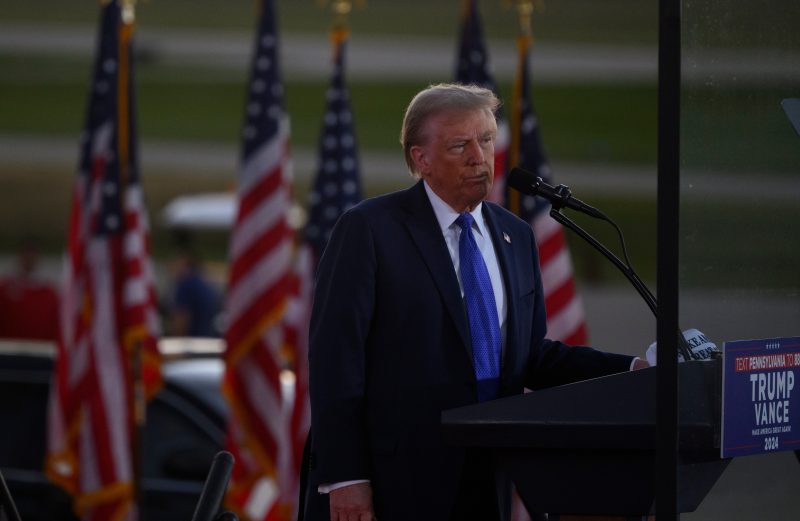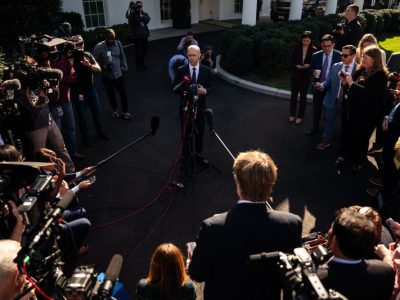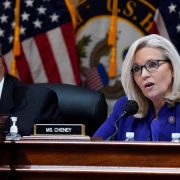
Democrats have spent the last year eyeing a familiar trio of northern states that would deliver the White House in November: Wisconsin, Michigan and Pennsylvania are the “clearest pathway” to victory, Vice President Kamala Harris’s campaign leaders wrote in July — as long as she also picks up a single electoral vote in the Omaha area.
The Trump team, meanwhile, has been focused on its own path in the Eastern time zone, a veritable “Red Wall” trifecta that overlaps with the northern “Blue Wall” around the Great Lakes.
“As long as we hold North Carolina, we just need to win Georgia and Pennsylvania,” a Trump campaign official told reporters last month in a strategy briefing. “That is all we need to win. So when everybody is running around with all the machinations, she’s still playing defense.”
The different strategies, which both hinge on a win in Pennsylvania, have been reflected in ad spending by both campaigns and the super PACs supporting them, according to AdImpact, which tracks spending and reservations on television, radio and digital platforms for ads that have already run. The data shows that the Trump and Harris camps largely agree on the seven principal states where they will advertise and the several more where they have hired staff. But the two sides have deployed decidedly different battle plans.
Republicans, for instance, have spent 19 percent of their ad money between March 12 and Sept. 3 in the presidential contest in Georgia, compared with the 11 percent Democrats have spent. Democrats have focused 16 percent of their spending in Michigan, compared with 12 percent of the Republican spending.
Republicans, meanwhile, have moved a greater share of their chips into Pennsylvania, which given its size is likely to hold the key to the election if the outcome is close. That state has seen 36 percent of Republican ad dollars, compared with 21 percent for the Democratic side.
“Pennsylvania and Georgia have taken center stage for the final act of this election,” said John Ashbrook, a Republican strategist. “The map becomes nearly impossible for Republicans without Georgia, and it becomes nearly impossible for Democrats without Pennsylvania.”
The fall electoral college chess game, a vestige of 18th-century concerns that the Founding Fathers had about majority rule, always produces complex gamesmanship late in presidential contests. But this year the map is historically small, the margins in the key states are expected to be tiny, and the various paths each candidate has to victory appear more limited.
Both major-party campaigns continue to have staff in states such as Minnesota, Virginia and New Hampshire, where Harris made a visit Sept. 4. But both campaigns have focused their spending on a smaller footprint of just seven states — Arizona, Georgia, Michigan, Nevada, North Carolina, Pennsylvania and Wisconsin — as well as Nebraska’s 2nd Congressional District.
Within that core battleground, the Trump team has identified a subset of voters, called “Target Persuadables,” that makes up about 11 percent of the voting pool and is the focus of much of their spending. A separate program within Trump’s coordinated campaign is focused on turning out voters who lean Republican but are not certain to get to the polls or turn in a ballot.
The Harris campaign — which has raised and spent much more money — has a more ambitious plan for voter communication, with more money going to more states and with a greater reliance on national advertising buys that do not target specific states. Eighteen percent of the money spent by the Harris side has been spent nationally, compared with 8 percent on the Trump side.
Harris also has a much bigger operation overall. On the whole, the Democratic side had spent or reserved at least $933 million for advertising as of Sept. 3, compared with $485 million on the GOP side. That spread could narrow over the coming weeks, because Republicans have been less aggressive than Democrats in making future ad reservations tracked by AdImpact.
But the Harris campaign has not tried to hide the fact that it has a more geographically expansive plan than its Republican counterpart.
“Our campaign strategy relies on a wide map: Trump is all in on one to two ‘must win’ states. We don’t have that luxury. Every single battleground state is close, so we need to compete aggressively in every state to build a pathway to 270 electoral votes,” Harris campaign chair Jen O’Malley Dillon said in a memo to top donors on Sept. 7.
The Harris effort, including independent groups, has put about 13 percent of its state-specific advertising resources into Arizona and Nevada, compared with about 9 percent for the Trump campaign and allied groups, according to AdImpact. A win in both those states for Harris would make up for a loss in either Wisconsin or Michigan, giving her an electoral college victory if she carried Pennsylvania.
The challenge Harris faces is that if she held Michigan and Wisconsin but lost Pennsylvania’s 19 electoral votes, she would need to win North Carolina or Georgia and one of the two Western states to make up the difference.
One of the major groups supporting Harris, American Bridge 21st Century — which has spent or reserved $44 million so far — has decided to focus all of its spending in Wisconsin, Pennsylvania and Michigan. Future Forward, the other major Democratic super PAC, has spread its spending across all the battlegrounds, including the Omaha media market in Nebraska.
On the Republican side, the two largest advertising super PACs have roughly divided up the states, with a notable overlap in Pennsylvania. Preserve America PAC, backed by casino magnate Miriam Adelson, has focused on Michigan, Wisconsin and Pennsylvania, while MAGA Inc. has focused on Georgia, Arizona, Nevada and Pennsylvania.
Recent polls in North Carolina have shown a close race, with Harris leading in an early-September survey by Quinnipiac University by three points among likely voters. That has raised concerns among Republican strategists about the integrity of their eastern “Red Wall.” Democratic strategists continue to view Georgia as a more favorable state than North Carolina, in part because of its higher percentage of Black voters.
After Harris’s strong debate performance this week, Republican allies of Trump are no longer talking about the sweep they saw as a possibility this summer, when President Joe Biden was crashing in polling. Former House speaker Kevin McCarthy, echoing the Trump campaign’s early pitch, said Wednesday that voters should focus on the strongest bulwark for another Trump term.
“It comes down to two states — it’s Pennsylvania and Georgia,” McCarthy said on CNBC. “If Trump carries exactly what he did before, and he wins Pennsylvania and Georgia, he is at 270. He doesn’t need Arizona. He doesn’t need Nevada.”
Clara Ence Morse contributed to this report.










